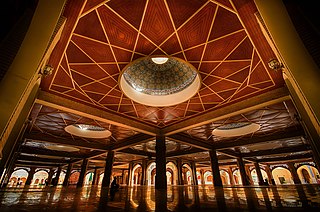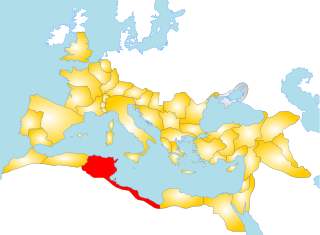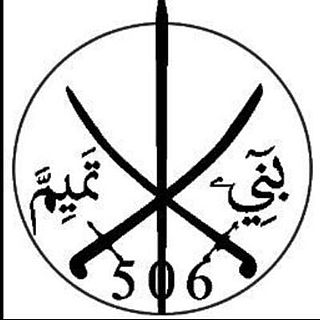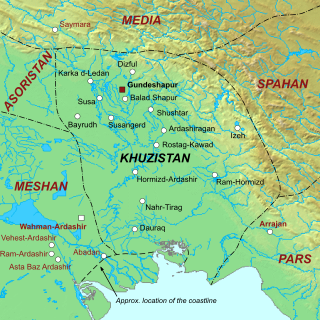Related Research Articles

Khuzestan province is one of the 31 provinces of Iran. Located in the southwest of the country, the province borders Iraq and the Persian Gulf, covering an area of 63,238 square kilometres (24,416 sq mi). Its capital is the city of Ahvaz. Since 2014, it has been part of Iran's Region 4.

Kufa, also spelled Kufah, is a city in Iraq, about 170 kilometres (110 mi) south of Baghdad, and 10 kilometres (6.2 mi) northeast of Najaf. It is located on the banks of the Euphrates River. The estimated population in 2003 was 110,000. Currently, Kufa and Najaf are joined into a single urban area that is mostly commonly known to the outside world as 'Najaf'.

Ifriqiya, also known as al-Maghrib al-Adna, was a medieval historical region comprising today's Tunisia and eastern Algeria, and Tripolitania. It included all of what had previously been the Byzantine province of Africa Proconsularis and extended beyond it, but did not include the Mauretanias.

Gundeshapur was the intellectual centre of the Sassanid Empire and the home of the Academy of Gundeshapur, founded by Sassanid Emperor Shapur I. Gundeshapur was home to a teaching hospital and had a library and a centre of higher learning. It has been identified with extensive ruins south of Shahabad, a village 14 km south-east of Dezful, to the road for Shushtar, in the present-day province of Khuzestan, southwest Iran.

Greater Tunb and Lesser Tunb are two small islands in the eastern Persian Gulf, close to the Strait of Hormuz. They lie at 26°15′N55°16′E and 26°14′N55°08′E, respectively, some 12 kilometres (7.5 mi) from each other and 20 kilometres (12 mi) south of the Iranian island of Qeshm. The islands are administered by Iran as part of its Hormozgan Province.

The Muslim conquest of Persia, also called the Muslim conquest of Iran, the Arab conquest of Persia, or the Arab conquest of Iran, was a major military campaign undertaken by the Rashidun Caliphate between 632 and 654. As part of the early Muslim conquests, which had begun under Muhammad in 622, it led to the fall of the Sasanian Empire and the eventual decline of Zoroastrianism, which had been predominant throughout Persia as the nation's official religion. The persecution of Zoroastrians by the early Muslims during and after this conflict prompted many of them to flee eastward to India, where they were granted refuge by various kings.

Banū Tamīm is an Arab tribe that originated in Najd in the Arabian Peninsula. It is mainly present in Saudi Arabia, Qatar, Kuwait, Iraq, Jordan and Lebanon, a strong presence in Algeria, and Morocco, Palestine, Tunisia, and Libya. It is also present in many other parts of the Arab world such as Egypt and Khuzestan in Iran. The word Tamim in Arabic means strong and solid. It can also mean those who strive for perfection.

Mansa Sulayman was mansa of the Mali Empire during the middle of the 14th century. He was the brother of Mansa Musa and succeeded Musa's son Magha as mansa.

The Muslim conquest of Khuzestan took place from 637/8 to 642, and ended with the acquisition of the rich Khuzestan Province by the Rashidun Caliphate.
Uthman ibn Abi al-As al-Thaqafi was a companion of the Islamic prophet Muhammad from the tribe of Banu Thaqif and the governor of Bahrayn and Oman in 636–650, during the reigns of caliphs Umar and Uthman. During his governorship he led military campaigns against the Sasanian Persians in Fars. After his dismissal, he settled with his brothers in Basra where he was granted a large estate by the caliph. He transmitted numerous hadiths to the scholar al-Hasan al-Basri and died in the city.

Umar was the second Rashidun Caliph and reigned during 634–644. Umar's caliphate is notable for its vast conquests. Aided by brilliant field commanders, he was able to incorporate present-day Iraq, Iran, Azerbaijan, Armenia, Georgia, Syria, Jordan, Palestine, Lebanon, Egypt, and parts of Afghanistan, Turkmenistan and south western Pakistan into the Caliphate. During his reign, the Byzantines lost more than three fourths of their territory and in Persia, and Umar was the king (ruler) of the Sassanid Empire before it ceased to exist.

Hormuzan was a Persian aristocrat who served as the governor of Khuzestan, and was one of the Sasanian military officers at the Battle of al-Qādisiyyah. He was later taken prisoner by the Muslims after the fall of Shushtar in 642. Two years later, he was accused of the assassination of the Rashidun caliph Umar, and was killed by Ubayd Allah, the deceased caliph's son.

Shia Islam in Iraq has a history going back to the times of Ali ibn Abi Talib, the first imam of Shia Islam and fourth caliph of Sunni Islam who moved the capital of the early caliphate from Medina to Kufa two decades after the death of Muhammad. In 2003, Shia Muslims made up around 55% of the Iraqi population. Iraq is the location of the holy cities of Najaf and Karbala, pilgrimage sites for millions of Shia Muslims.
Arfajah ibn Harthama al-Bariqi was a companion of the Islamic prophet Muhammad. He was a member of the Azd branch of the Bariq clan that inhabited Southwestern Arabia.

The siege of Shushtar was fought from 641 to 642 between the Sasanian Empire and the invading Arab Muslims of the Rashidun Caliphate. Shushtar was an ancient strong stronghold in Khuzestan, and was attacked by the Arabs under their commander Abu Musa Ashaari. Although the city managed to resist the Arabs, the Sasanians later faced desertion, which resulted in the Arabs capturing the city and capturing its commander, Hormuzan.
The Asawira were a military unit of the Rashidun and Umayyad Caliphate. The unit consisted of Iranian noblemen who were originally part of the aswaran unit of the Sasanian army. It was disbanded in 703 by al-Hajjaj ibn Yusuf.

Pars was a Sasanian province in Late Antiquity, which almost corresponded to the present-day province of Fars. The province bordered Khuzestan in the west, Kirman in the east, Spahan in the north, and Mazun in the south.

Abu Musa Abd Allah ibn Qays al-Ash'ari, better known as Abu Musa al-Ash'ari was a companion of Muhammad and an important figure in early Islamic history. He was at various times governor of Basra and Kufa and was involved in the early Muslim conquest of Persia.

Khuzistan or Huzistan was a Sasanian province in Late Antiquity, which almost corresponded to the present-day province of Khuzestan. Its capital was Gundeshapur. During the late Sasanian era, the province was included in the southern quadrant (kust) of Nemroz.
Majzaʾa ibn Thawr al-Sadūsī, was a Muslim army commander and a companion of the Prophet who hailed from the clan of Sadus, a branch of the Banu Shayban tribe. Majza'a was said have attended 80 military battles during his life. He died during the Siege of Shushtar (641/642), in a battle with the Sassanian commander Hormuzan, although other sources reported that he was slain during the campaign in Basra.
References
- 1 2 3 Jalalipour 2014, pp. 11–12.